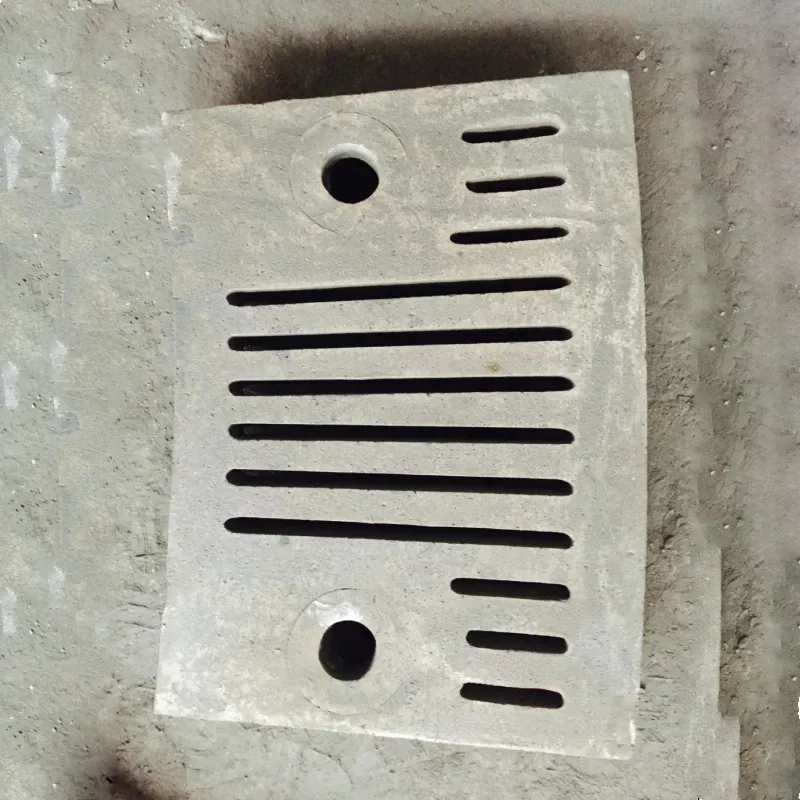Sep . 02, 2025 19:50 Back to list
High manganese steel lining plate | Shijiazhuang Chengda Wear Resistant Materials Co., Ltd. | Wear Resistance&Impact Strength
Product Overview
High-manganese steel, also known as Hadfield steel, is a specialized material designed to withstand severe impact and abrasion. With a chemical composition of 10%-15% manganese and 0.90%-1.50% carbon, this steel offers unparalleled strength and toughness. Its unique property of surface hardening under stress makes it ideal for demanding applications in mining, metallurgy, and heavy machinery.

Image: High-manganese steel lining plates in a mining application.
Key Features and Advantages
- Exceptional Wear Resistance: High-manganese steel undergoes surface hardening upon impact, ensuring long-term durability in abrasive environments.
- High Impact Strength: The material's core retains toughness even after surface wear, preventing fractures under extreme stress.
- Adaptability: Secondary hardening after surface wear extends the lifespan of components in dynamic industrial settings.
- Wide Application Range: Suitable for mining, construction, military, and power generation industries due to its robust performance.
Technical Specifications
| Parameter | Details |
|---|---|
| Chemical Composition | High Manganese (10%-15%), High Carbon (0.90%-1.50%) |
| Hardness | Surface Hardness: 300-400 HB; Core Toughness: 150-200 HB |
| Impact Resistance | Exceeds 150 J (tested under ASTM E23 standards) |
| Application Environments | Mining, Metallurgy, Railways, Power Generation |
| Standard Compliance | ISO 4967, ASTM A128, EN 10204 |
Applications in Industrial Settings
High-manganese steel lining plates are critical in environments where mechanical stress and abrasion are prevalent. Their applications include:
- Mineral Processing: Used in ball mill liners and sag mill liners to reduce wear in grinding operations.
- Construction Machinery: Ideal for excavator buckets and conveyor systems due to their resistance to material abrasion.
- Military Equipment: Deployed in armored vehicles and heavy machinery for enhanced durability under combat conditions.
- Energy Sector: Applied in coal mining and power generation equipment to withstand high-impact loads.

Image: High-manganese steel components in a ball mill application.
Company Background: Shijiazhuang Chengda Wear Resistant Materials Co., Ltd.
Founded in [year], Shijiazhuang Chengda Wear Resistant Materials Co., Ltd. has become a leading manufacturer of wear-resistant materials, specializing in high-manganese steel products. The company's commitment to innovation and quality ensures that its solutions meet the rigorous demands of global industries. With a focus on research and development, Chengda provides customized solutions for mining, construction, and heavy machinery sectors.
As a trusted supplier, Chengda adheres to international standards such as NIST (National Institute of Standards and Technology) guidelines for material testing and performance validation. Their products are engineered to exceed industry expectations, ensuring reliability and cost-effectiveness for clients worldwide.
Why Choose High-Manganese Steel?
Compared to traditional materials like carbon steel or cast iron, high-manganese steel offers superior performance in high-stress environments. Its ability to self-harden under impact reduces the need for frequent replacements, lowering maintenance costs. Additionally, its versatility allows it to be tailored for specific applications, such as ball mill rubber lining or ball mill shell liners, ensuring optimal efficiency in industrial processes.
Future Prospects and Innovations
As technology advances, the potential of high-manganese steel continues to expand. Recent applications include ball mill liners for sale in automated mining systems and components for magnetic levitation trains. These innovations highlight the material's adaptability and its role in shaping the future of industrial engineering.
-
Expert Insights on Fabrica de Molinos de Bolas: Industry Trends & Global Applications
NewsNov.24,2025
-
Expert Insights on Fabricantes de Bolas de Molienda de Acero: Global Applications & Trends
NewsNov.23,2025
-
Leading Fabricantes de Bolas de Molienda: Your Ultimate Guide to Grinding Balls
NewsNov.23,2025
-
Fabricante de Bolas de Molienda – Quality Grinding Balls for Efficient Industry
NewsNov.23,2025
-
Trusted Proveedores de Medios de Molienda for Efficient Industrial Grinding
NewsNov.22,2025
-
Proveedores de Bolas de Molienda: Your Guide to Top Grinding Ball Suppliers & Industry Insights
NewsNov.22,2025
Realted Products
















